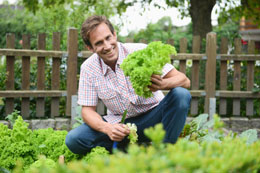An indoor vegetable garden is one of the best ways to have fresh vegetables at your disposal at any time. Read this article for some tips on the process.

If you are a gardening enthusiast, but your efforts to have a flourishing garden in the open are proving to be futile, then how about another option that will give you the same amount of mental satisfaction, and an array of delicious and healthy vegetables too? Yes, you guessed it right. It's an indoor vegetable garden that we're talking about. Growing a vegetable garden indoors will give you many benefits, which will be discussed below.
How to Grow a Vegetable Garden Indoors
Indoor gardening is a fantastic idea for those with limited outdoor space. In the paragraphs below, we will discuss a complete garden design that will take care of all the aspects of planting and caring for it.
Pre-Gardening
Before actually going about the planting of the garden, let us see some basic steps that you need to take, in order to ensure that your garden remains healthy and fresh. Given below are some pre-gardening measures that you can take.
- Select a spot in your home where you want the garden to be.
- Choose a spot which receives adequate sunlight and is slightly away from the central part of the house.
- Since it is most definitely going to be a container garden, you need to equip yourself with appropriate containers.
- The best option for containers will be earthen or ceramic ones. Plastic gets heated due to sunlight and may harm the plants.
- Also, make sure that the containers you use are cleaned thoroughly if they have been used for some other purpose earlier. You don't want the plants getting infected due to toxic substances mixing with the soil.
- Another thing you should keep in mind is that the containers should be able to bear the weight of the plants that you intend to plant in them.
- For instance, lightweight containers will not be a suitable option if you're planning to have vines and creepers hanging from the containers, right?
- After the containers, you need to pick out the vegetables that you want to plant.
- Once the plants have been decided, you can move forward with the gardening process.
Gardening
Indoor vegetable gardening is quite easy once you know exactly what you need and what to do with what you have. Once you're done with the planning and other steps mentioned above, you can move on to the actual gardening. Just follow the simple instructions given below and have a thriving indoor vegetable garden for yourself.
- First, decide the vegetables that you want to plant.
- Choose two or three vegetables that require similar soil types and sunshine. This way, you can have a variety of plants growing at the same time and you don't have to stress about their care too much.
- Best options for indoor gardens are small and easy to grow veggies like carrots, radishes, beetroot, potatoes, peppers, okra, etc.
- As far as soil is concerned, you'll need to make a little extra effort in the initial stage. Meaning, you can't just pick up soil from outside your home and use it for growing seedlings indoors.
- You'll need soil that has less clay and more silica and zinc in it.
- Another thing that you must check for in the soil is that it drains water easily. This is because in a container, the soil remains moist and sometimes excess moisture can be harmful for the plants.
- Instead, have a fixed schedule of watering the plants on a regular basis according to their needs.
Post-Gardening
After you have successfully planted the vegetables of your choice, you need to take good care of them, so that they can bear good and healthy vegetables, ready to be eaten by you and your family. This involves the soil and sun requirements, which have already been discussed above. In addition, you need to carry out simple steps like using natural insecticides, draining the soil of excess water, using good organic fertilizers in the soil, and checking regularly for infestation or diseases. There are fewer chances of infestation as indoor gardens grow in a reasonably controlled environment.
As you can see, apart from the size and the 'indoor' part, growing an indoor vegetable garden is quite similar to a normal outdoor one. And the best part is that, once you've used up the fresh and luscious vegetables of one batch of plants, you can repeat the procedure with another batch! So, go ahead and get gardening!






 If you are a gardening enthusiast, but your efforts to have a flourishing garden in the open are proving to be futile, then how about another option that will give you the same amount of mental satisfaction, and an array of delicious and healthy vegetables too? Yes, you guessed it right. It's an indoor vegetable garden that we're talking about. Growing a vegetable garden indoors will give you many benefits, which will be discussed below.
If you are a gardening enthusiast, but your efforts to have a flourishing garden in the open are proving to be futile, then how about another option that will give you the same amount of mental satisfaction, and an array of delicious and healthy vegetables too? Yes, you guessed it right. It's an indoor vegetable garden that we're talking about. Growing a vegetable garden indoors will give you many benefits, which will be discussed below.